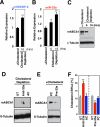MicroRNA-33 and the SREBP host genes cooperate to control cholesterol homeostasis
- PMID: 20466882
- PMCID: PMC3840500
- DOI: 10.1126/science.1189123
MicroRNA-33 and the SREBP host genes cooperate to control cholesterol homeostasis
Abstract
Proper coordination of cholesterol biosynthesis and trafficking is essential to human health. The sterol regulatory element-binding proteins (SREBPs) are key transcription regulators of genes involved in cholesterol biosynthesis and uptake. We show here that microRNAs (miR-33a/b) embedded within introns of the SREBP genes target the adenosine triphosphate-binding cassette transporter A1 (ABCA1), an important regulator of high-density lipoprotein (HDL) synthesis and reverse cholesterol transport, for posttranscriptional repression. Antisense inhibition of miR-33 in mouse and human cell lines causes up-regulation of ABCA1 expression and increased cholesterol efflux, and injection of mice on a western-type diet with locked nucleic acid-antisense oligonucleotides results in elevated plasma HDL. Our findings indicate that miR-33 acts in concert with the SREBP host genes to control cholesterol homeostasis and suggest that miR-33 may represent a therapeutic target for ameliorating cardiometabolic diseases.
Figures




Comment in
-
Medicine. HDL miR-ed down by SREBP introns.Science. 2010 Jun 18;328(5985):1495-6. doi: 10.1126/science.1192409. Science. 2010. PMID: 20558698 Free PMC article.
-
Cardiovascular disorders: MicroRNA modulation of cholesterol.Nat Rev Drug Discov. 2010 Jul;9(7):515. doi: 10.1038/nrd3208. Nat Rev Drug Discov. 2010. PMID: 20592742 No abstract available.
References
Publication types
MeSH terms
Substances
Grants and funding
LinkOut - more resources
Full Text Sources
Other Literature Sources
Medical
Molecular Biology Databases

